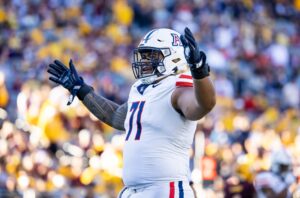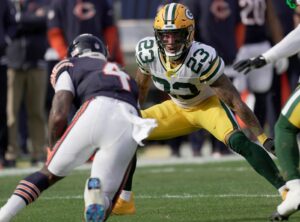One of my favorite ways to anticipate fantasy regression for players is to examine how heavily they rely on touchdowns. Weekly touchdown scoring is highly unreliable. Therefore, we can identify fantasy football regression candidates based on how much of their production is based on scoring touchdowns.
Here are four players from each position that could see a huge change in their weekly production as we approach the fantasy football playoffs.
2020 Fantasy Football Regression Candidates
Quarterbacks
QB: Aaron Rodgers – Green Bay Packers
Value: 52.2%
Anticipated Regression: Negative
Rodgers ranks fourth in passing yards (2889), but has continued to see a dramatic decrease in his rushing yardage. His rushing yards per game has dropped each of the past three seasons from 16.8 to just 7.8 this season. Rodgers’ one rushing touchdown through nine games is around his seasonal norm, but his 29 passing touchdowns put him on pace for the most since he led the league with 40 in 2016. With a lack of consistent running production, a healthy Aaron Jones, and head coach Matt LaFleur‘s rushing preference, Rodgers is a prime candidate to see a dip in his 23.4 fantasy points per game. Green Bay’s schedule is favorable, and includes three upcoming home games against Philadelphia, Carolina, and Tennessee. However, the Packers only rank 20th in passing percentage, which could translate to more volume for the Green Bay ground attack.
QB: Baker Mayfield – Cleveland Browns
Value: 47.8%
Anticipated Regression: Negative
Mayfield only ranks 27th in passing yardage, making his 15 passing touchdowns over 71% percent of his fantasy production. Nine of Mayfield’s 10 games have failed to yield an overall QB1 performance, even managing to only tally the overall QB6 line when he passed for five touchdowns against Cincinnati in Week 7. With only 75 rushing yards on 25 carries, Mayfield is nothing more than a stationary game manager. The Browns lost leading wide receiver Odell Beckham Jr. and now have a healthy Nick Chubb, reducing Mayfield’s fantasy value even more. I have little confidence in Mayfield despite favorable road games against the Jaguars, Titans, and Jets.
QB: Daniel Jones – New York Giants
Value: 35.6%
Anticipated Regression: Positive
Jones has been a huge disappointment this season, with just eight touchdowns and nine interception while ranking just 21st in passing yards (2114). However, he will now start one of the most favorable stretches of opponents for any fantasy quarterback. Starting this week at Cincinnati, Jones will face four consecutive opponents that rank in the bottom third of the league in fantasy points allowed to quarterbacks. Jones’ 38.4 rushing yards per game ranks fourth, with 64 rushing yards or more in three of his past five games. Over his past three games, Jones has three overall QB13 or better performances. If he can just find a couple more touchdown passes per game, Jones could be a high-end QB1 the remainder of the fantasy season.
QB: Matthew Stafford – Detroit Lions
Value: 34.1%
Anticipated Regression: Positive
Matthew Stafford's time in Detroit summed up in one GIF
(via @ChadwikoRCC) pic.twitter.com/YspIppQNqj
— Pick Six Podcast (@picksixpod) November 15, 2020
Injuries have limited Stafford and his offensive weapons all season. He has only produced three Top 12 fantasy QB performances out of his ten games. His 17 passing touchdowns rank outside the Top 14 quarterbacks, and his limited rushing yardage has compounded to drag down his fantasy value. If he can just get Kenny Golladay, Danny Amendola, and D’Andre Swift back, Stafford could really take advantage of some great upcoming matchups. Detroit host Houston this week with a Week 15 road battle at Tennessee. He only has three games of three or more touchdowns, after having five in just a nine-game season last year.
Running Backs
RB: Todd Gurley – Atlanta Falcons
Value: 38.7%
Anticipated Regression: Negative
At the risk of beating a dead horse, Gurley is due for negative regression. He only ranks 11th in rushing yards (610) despite having the sixth-most carries (167). Per PlayerProfiler, his anemic -11.6 Production Premium ranks 54th at the position. Gurley’s nine total touchdowns ranks third, and has greatly bolstered his fantasy production even in PPR formats. He has been non-existent in the passing game with just 16 receptions and an unimpressive 82 total receiving yards. Gurley has managed a touchdown in seven of his 10 games, a simply unsustainable percentage.
RB: Ezekiel Elliott – Dallas Cowboys
Value: 25.2%
Anticipated Regression: Positive
Dallas has suffered through the loss of Dak Prescott and both starting tackles, Tyron Smith and La’el Collins this season. Ezekiel Elliott has grinded his way to the sixth-most running back points per game behind exceptional volume. He ranks fifth in carries, fourth in RB targets, and first in routes run. Yet, Elliott has only generated 3.9% of his fantasy points from touchdowns. With Andy Dalton now back at quarterback, Elliott could salvage his season with a strong fantasy finish. Granted, he will have to do so against a difficult schedule that includes home games with San Francisco and Philadelphia, along with a road trip to Baltimore. Despite the Cowboys season-long struggles, Elliott does have positive touchdown regression working in his favor.
RB: Miles Sanders – Philadelphia Eagles
Value: 17.3%
Anticipated Regression: Positive
Very few running backs have experienced worse luck than Miles Sanders. First, he battled three of the NFL toughest run defenses in San Francisco, Pittsburgh, and Baltimore on consecutive weeks. Second, he broke free for a 74-yard run against the Ravens that should have been a touchdown, if not for a missed block by JJ Arcega-Whiteside. On that play he injured his hip and missed four weeks.
Miles Sanders fumbles and Arcega-Whiteside picks it up for a TD 😅
(via @Eagles)pic.twitter.com/Iaz7Jn3VLA
— Bleacher Report (@BleacherReport) October 18, 2020
Third, he returned in Week 10 and earned a 77% snap share, but saw fellow running backs Boston Scott and Corey Clement earn the rushing touchdowns. Lastly, he had horrific weather in Cleveland last week that limited his performance. Sanders 78.4% opportunity share ranks fourth among all running backs. He averages five targets per game and ranks seventh at the position with a 13.5% target share. He has favorable upcoming matchups against Seattle, at Green Bay, at Arizona, and at Dallas. With a little positive touchdown regression, Sanders is a Top 5 fantasy back rest of season.
RB: Zack Moss – Buffalo Bills
Value: 6.4%
Anticipated Regression: Negative
Moss has taken control of the Buffalo backfield over the past four weeks. He has averaged 9.3 carries, two targets, and totaled three touchdowns. Over that time, Moss has produced two overall Top 15 RB stat lines. However, Moss’s snap share in those four game has been: 47.1%, 51.8%, 59.6%, and 52.9%. Buffalo faces two the league’s toughest run defenses in Week 13 (at San Francisco) and Week 14 (Pittsburgh). For Moss to even approach another high-end RB2 performance, he either needs a massive volume increase or more touchdowns. This remains a split backfield with teammate Devin Singletary and quarterback Josh Allen‘s 16 red zone carries always pose a threat to Moss’ goal line work. If you have Zack Moss on your fantasy team, consider putting him on the bench in favor of a higher upside Flex play.
Wide Receivers
WR: Mike Evans – Tampa Bay Buccaneers
Value: 34.5%
Anticipated Regression: Negative
This is the obvious wide receiver candidate for negative regression. Evans has generated the fourth-most fantasy points from touchdowns among all wide receivers. He ranks 25th in receptions (40), 27th in receiving yards (514), yet is fifth in total touchdowns (eight) among all wide receivers. Evans greatly benefitted from Chris Godwin‘s absence, and tallied six touchdowns over the first five games. With Antonio Brown now siphoning targets and a more efficient Rob Gronkowski, Evans fantasy production will continue to plummet. After a Week 12 bye, Tampa Bay faces three favorable defenses for their wide receivers in Minnesota, Atlanta, and Detroit. But don’t expect Evans to even approach his early season production.
WR: Robby Anderson – Carolina Panthers
Value: 3.7%
Anticipated Regression: Positive
Robby Anderson currently has a 27% target share with just 1 touchdown. Only one WR has finished a season since 2011 with at least 25% of his team's targets and 1 (or fewer) touchdown: Brian Hartline in 2012. Vincent Jackson ('14) and Kendall Wright ('13) each had 2 TDs.
— JJ Zachariason (@LateRoundQB) November 23, 2020
If any wide receiver is due for positive touchdown regression, it is Carolina’s Robby Anderson. He is fourth at the position in targets (88), receptions (64), fifth in receiving yards (764), yet only has one total touchdown. Anderson has a 27.1% team target share and has seen eight red zone targets. His only touchdown occurred back in Week 1, meaning he has gone nine games without a touchdown. He should feast next week against a Minnesota team that allows the 28th-most fantasy points to opposing wide receivers. Fantasy owners deserve some positive regression, and logic says that should come during the fantasy playoffs.
WR: Cooper Kupp – Los Angeles Rams
Value: 9.6%
Anticipated Regression: Positive
Kupp has two things working in his favor for positive touchdown regression: volume and a great schedule. Just two weeks ago, Kupp saw 21 targets against Miami. He has 30 receptions over the past five weeks without a touchdown. In 2019, Kupp was second among all wide receivers with ten touchdowns. The Rams have a fantastic upcoming schedule with pass defenses that should allow for touchdown opportunities. Los Angeles will travel to Arizona and Seattle, with a home game against the lowly Jets in Week 15. Kupp owners should get ready for a strong end to the fantasy season.
WR: Nelson Agholor – Las Vegas Raiders
Value: 34.5%
Anticipated Regression: Negative
BEAUTIFUL pass and catch for the @Raiders TD. @derekcarrQB ➡️ Nelson Agholor
📺: #KCvsLV on NBC
📱: NFL app // Yahoo Sports app: https://t.co/O0IlFC03uf pic.twitter.com/HAhpps1NGz— NFL (@NFL) November 23, 2020
It’s difficult to project Agholor to maintain this touchdown pace. He has just 24 receptions but six total touchdowns, which makes for an insane 4 to 1 reception to touchdown ratio. In 2015, former Jaguars wide receiver Allen Hurns finished with 10 touchdown on just 64 receptions, for a 6.4 to 1 ratio. Unless Agholor can maintain this historic pace, he is very likely to see negative regression. Last week’s return of rookie wideout Bryan Edwards should limit Agholor’s opportunities even further. Las Vegas quarterback Derek Carr also ranks just 20th among all quarterbacks in pass attempts. In a low volume offense with unsustainable touchdown efficiency, Nelson Agholor is the poster boy for wide receiver scoring regression.
Tight Ends
TE: Jonnu Smith – Tennessee Titans
Value: 40.3%
Anticipated Regression: Negative
Of all the non-quarterbacks on this list, no player has seen a higher percentage of their fantasy points come from touchdowns than Jonnu Smith. He leads the position with eight total touchdowns, one more than clear TE1 Travis Kelce. Smith has tallied 11.9 PPR points, with 48 of those coming from touchdowns. Smith even had the rare tight end rushing touchdown.
Jonnu Smith rushing TD 😯
This Titans play call >
(via @nfl) pic.twitter.com/oJPAJuHMbZ
— B/R Gridiron (@brgridiron) November 13, 2020
Smith ranks just 15th among tight ends in targets (49) and receptions (30), but fifth among active TEs in PPR fantasy points per game (11.2). Tennessee faces the second and third-toughest defenses against opposing tight ends with road games at Indianapolis in Week 12 and at Green Bay in Week 16. With teammate Andrew Firkser also getting 39 targets, Smith is likely to disappoint during the fantasy playoffs.
TE: Austin Hooper – Cleveland Browns
Value: 10.5%
Anticipated Regression: Positive
Hooper is one of the few tight ends that could be a difference-maker during the fantasy playoffs. Only 10.5% of his fantasy points have been generated by his one touchdown on the season. Before missing time due to an emergency appendectomy, Hooper had generated three consecutive TE1 weeks with five receptions in each game. With Odell Beckham now out and Jarvis Landry still underperforming, Hooper could be the top target for quarterback Baker Mayfield. The Browns have a very friendly upcoming schedule for Hooper, including Jacksonville, Tennessee, and the Jets. All three teams rank in the bottom third in points allowed to opposing tight ends. At the shallow fantasy tight end position, Hooper could be a championship difference-maker.
TE: Dallas Goedert – Philadelphia Eagles
Value: 19.5%
Anticipated Regression: Positive
Goedert had separated himself from fellow tight end Zach Ertz before an ankle fracture landed him on the injured reserve. Most fantasy gamers will forget he was the overall Week 1 tight end with eight receptions, 101 yards, and a touchdown. That represented his only touchdown of the season, and as his 96.7% Week 10 snap share indicates, more opportunities will be forthcoming. Philadelphia has a fantastic Week 14 home matchup against New Orleans, who ranks fifth-most generous to opposing tight ends. While Ertz is scheduled to return soon, Goedert is such an athletic weapon, that his value should not be affected. Even in a rain-soaked Week 11 game at Cleveland, Goedert found a way to a five reception, 77 yards, one touchdown performance.
TE: Jared Cook – New Orleans Saints
Value: 33.1%
Anticipated Regression: Negative
Cook has always been an inconsistent frustration for fantasy owners. In the past six weeks, he has three Top 10 fantasy TE finishes and three TE34 or worse performances. If his Week 11 one-reception, six receiving yard stat line is any indication, things will not improve under quarterback Taysom Hill. Cook has four touchdowns on just 22 receptions this season. While his nine red zone targets provide hope for fantasy players, the bigger issue is the emergence of rookie tight end Adam Trautman. Over the past two games Trautman has four receptions, 58 receiving yards, and a touchdown. Now sharing targets and without Hall of Fame quarterback Drew Brees, Cook cannot be counted on for consistent production during the fantasy playoffs.
Main photo:
Embed from Getty Images






